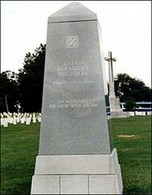3rd Infantry Division Monument, Arlington
Introduction
Text-to-speech Audio
Images
3rd Infantry Division.

Backstory and Context
Text-to-speech Audio
The division has a long history and was home to the most decorated soldier in World War II, Lieutenant Audie L. Murphy. The 3rd Division (later re-designated as the 3rd Infantry Division on August 1, 1942) was organized at Camp Greene, North Carolina, November 21, 1917. The division was composed of the 4th, 7th, 30th, and 38th Infantry Regiments, the 10th, 18th, and 76th FA Regiments, and the 6th Engineer Regiment, with a total of 28,000 men. It underwent training at Camp Green, North Carolina and Fort Bliss, Texas, and shipped to France, arriving in April 1918. The division earned the designation “Rock of the Marne” at the Marne River near Chateau-Thierry on July 15, 1918. When flanking units retreated, then Division Commander, Major General Joseph Dickman, told our French Allies “Nous Resterons La” (we shall remain here). This motto is on the 3rd Infantry Division’s distinctive insignia.
During WWII, the Division was credited with 531 combat days which was the most combat days of any unit in the European Theatre. The 3rd Infantry Division fought in places like Casablanca, Anzio, Rome, the Vosges Mountains, Colmar, the Siegfried Line, Palermo, Nurnberg, Munich, Berchtesgaden, and Salzburg. The 3rd Infantry Division was the only U.S. unit that served in all 10 campaigns of the war, participated in four amphibious landings, and suffered the most casualties of any U. S. unit in the theatre.
Early in the Korea Conflict, General MacArthur specifically asked for the 3rd Infantry Division for his Far East Command. The Division became known as “The Fire Brigade” for quickly moving up to cover breaks in the UN lines. On one cold and stormy night in May 1951, the division was given orders to disengage on the east coast and move all the way across Korea to stop a major enemy breakthrough in the west. No one thought it could be done, including the officers who gave the order. The officers and men of the 3rd Infantry Division loaded onto trucks, and 30 hours later, they engaged and stopped the advance of the large hostile force. The Chinese were amazed. They were fighting and losing to the 3rd Infantry Division, which they thought was still on the east coast.
The 3rd Infantry Division would be
called again and again, during the Cold War, Vietnam, the Gulf War, and Afghanistan.
With the close of combat operations in Iraq, the 3rd Infantry Division moved on to Afghanistan and continued combat operations and training
missions (advise and assist) to prepare the Afghan Army and police to take over
responsibility for security in a very difficult theater of operations.
The division and aviation brigade then redeployed to duty stations in the U.S. Soon
after, the Third Division again answered the call to arms with units deployed to hostile
territory in Afghanistan. These soldiers advise and assist missions train and prepare
the Afghan Army and security forces to take, hold, and occupy large areas of
their nation.
Sources
W, Kevin. Third Infantry Division, U.S. Army “Rock of the Marne”. The Historical Marker Database. June 16, 2016. Accessed April 26, 2019. https://www.hmdb.org/Marker.asp?Marker=11143.
History of the 3rd Infantry Division (Mechanized) “Rock of the Marne”. 3rd ID History. . Accessed April 26, 2019. http://society3rdid.org/3rd-division-history.
